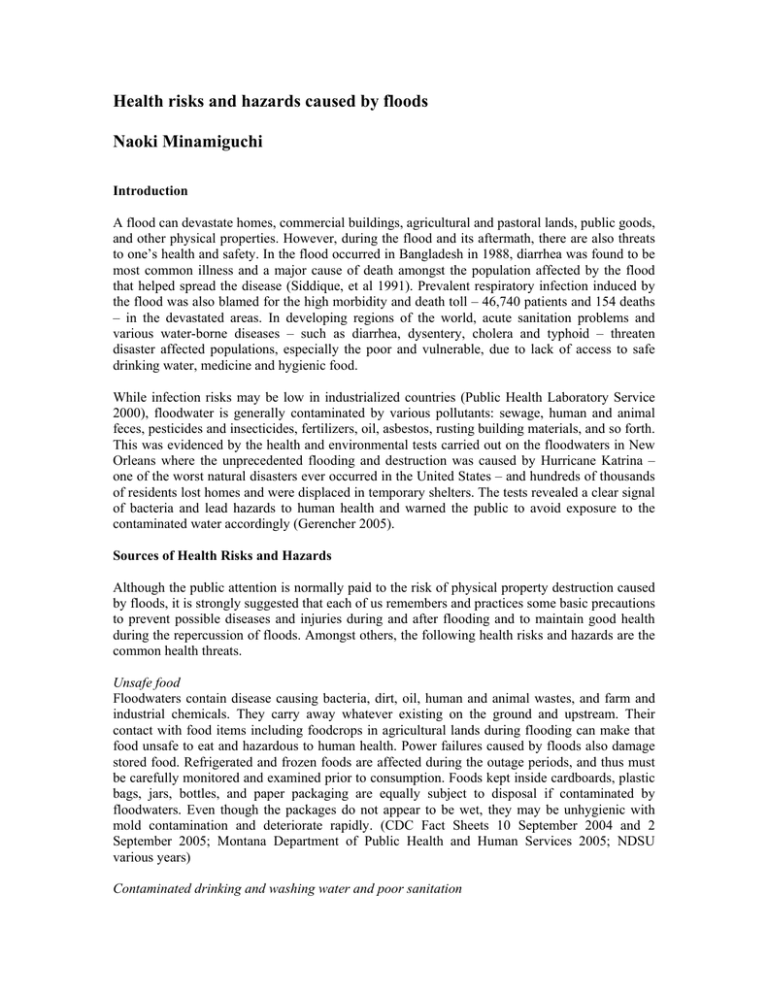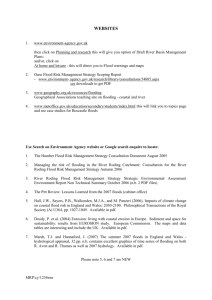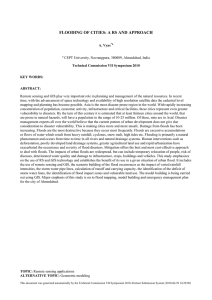Health risks and hazards caused by floods
advertisement

Health risks and hazards caused by floods Naoki Minamiguchi Introduction A flood can devastate homes, commercial buildings, agricultural and pastoral lands, public goods, and other physical properties. However, during the flood and its aftermath, there are also threats to one’s health and safety. In the flood occurred in Bangladesh in 1988, diarrhea was found to be most common illness and a major cause of death amongst the population affected by the flood that helped spread the disease (Siddique, et al 1991). Prevalent respiratory infection induced by the flood was also blamed for the high morbidity and death toll – 46,740 patients and 154 deaths – in the devastated areas. In developing regions of the world, acute sanitation problems and various water-borne diseases – such as diarrhea, dysentery, cholera and typhoid – threaten disaster affected populations, especially the poor and vulnerable, due to lack of access to safe drinking water, medicine and hygienic food. While infection risks may be low in industrialized countries (Public Health Laboratory Service 2000), floodwater is generally contaminated by various pollutants: sewage, human and animal feces, pesticides and insecticides, fertilizers, oil, asbestos, rusting building materials, and so forth. This was evidenced by the health and environmental tests carried out on the floodwaters in New Orleans where the unprecedented flooding and destruction was caused by Hurricane Katrina – one of the worst natural disasters ever occurred in the United States – and hundreds of thousands of residents lost homes and were displaced in temporary shelters. The tests revealed a clear signal of bacteria and lead hazards to human health and warned the public to avoid exposure to the contaminated water accordingly (Gerencher 2005). Sources of Health Risks and Hazards Although the public attention is normally paid to the risk of physical property destruction caused by floods, it is strongly suggested that each of us remembers and practices some basic precautions to prevent possible diseases and injuries during and after flooding and to maintain good health during the repercussion of floods. Amongst others, the following health risks and hazards are the common health threats. Unsafe food Floodwaters contain disease causing bacteria, dirt, oil, human and animal wastes, and farm and industrial chemicals. They carry away whatever existing on the ground and upstream. Their contact with food items including foodcrops in agricultural lands during flooding can make that food unsafe to eat and hazardous to human health. Power failures caused by floods also damage stored food. Refrigerated and frozen foods are affected during the outage periods, and thus must be carefully monitored and examined prior to consumption. Foods kept inside cardboards, plastic bags, jars, bottles, and paper packaging are equally subject to disposal if contaminated by floodwaters. Even though the packages do not appear to be wet, they may be unhygienic with mold contamination and deteriorate rapidly. (CDC Fact Sheets 10 September 2004 and 2 September 2005; Montana Department of Public Health and Human Services 2005; NDSU various years) Contaminated drinking and washing water and poor sanitation Flooding impairs clean water sources with pollutants and devastates sanitary toilets. Direct and indirect contact with the contaminants – whether through direct food intakes, vector insects such as flies, unclean hands, or dirty plates and utensils – result in waterborne illnesses and lifethreatening infection diseases. The pollutants also saturate into the ground water and/or can infiltrate into sanitary sewer lines through the ground. In addition, wastewater treatment plants, if flooded and malfunctioned, can be overloaded with polluted runoff waters and sewage beyond their disposal capacity, resulting into backflows of raw sewage to homes and low lying grounds. Private wells can be also contaminated or damaged severely by floodwaters, while private sewage disposal systems also become a cause of infection and illnesses when they are broken or overflowed (CDC Fact Sheets 10 September 2004 and 10 September 2005). In this manner, unclean drinking and washing water and sanitation, coupled with lack of adequate sewage treatment, can lead to disease outbreaks, e.g. life-threatening cholera, typhoid, dysentery and some forms of hepatitis as experienced in the floods in Bangladesh and New Orleans. Indeed, many lives were claimed by the infectious diseases broken out during and after the wave surges of the Indian Ocean Tsunamis and resultant floods that devastated regions along the coasts in Southeast and South Asian countries (Government of Western Australia; Indonesia Relief 2005; Rose 2005; WHO). The key to preventing a health catastrophe is therefore a basic hygiene: i.e. clean and safe water and toilets. Mosquitoes and animals Prolonged rainfall and floods provide new breeding grounds – wet areas and stagnant pools – for mosquitoes and can lead to an increase in the number of mosquito-borne diseases such as malaria and dengue and West Nile fevers (Montana Department of Public Health and Human Services 2005). It is also suggested to avoid contact with wild animals, rats and rodents that possibly carry viruses and diseases, and to get rid of dead animals in accordance with official guidelines issued by local animal control authorities if any (CDC Fact Sheet 10 September 2004). Leptospirosis, or Weil's disease – a zoonotic bacterial disease associated predominantly with rats – often accompanies floods in developing countries (Leptospirosis Information Center). The leptospirosis risk is however very low in the industrialized regions unless any cuts or wounds have direct contact with the disease contaminated floodwaters or animals. Molds and mildews Excessive exposure to molds and mildews can cause flood victims – especially those with allergies and asthma – to contract upper respiratory diseases and to trigger cold-like symptoms, e.g. sore throat, watery eyes, wheezing and dizziness (CDC 2006; FEMA 2005; North Carolina Department of Health and Human Services). Molds grow in as short a period as 24 to 48 hours in wet and damp areas of the buildings and homes that have not been cleaned after flooding such as water infiltrated walls, floors, carpets, toilets and bathrooms. Although molds exist naturally as well as in our normal life, very small mold’s spores can be easily inhaled by human bodies and cause allergic reactions, asthma episodes, and other respiratory problems if a large amount of molds are inbreathed. Amongst others, infants, children, elderly people, and pregnant women are considered most vulnerable to mold induced health problems. Carbon monoxide poisoning Post-flood carbon monoxide (CO) poisoning is reported to be a growing problem in many developed countries. CO can be found in combustion fumes, e.g. fumes generated by small gasoline engines, stoves, generators, lanterns, and gas ranges, or by burning charcoals and woods. In the event of power outages following floods, the flood victims tend to use alternative sources of fuels or electricity for heating, cooling, or cooking inside enclosed or partly enclosed houses, garages or buildings without an adequte level of air ventilation (Environmental Health Center 2001). CO builds up from these sources and poisons the people and animals inside. CO poisoning therefore should be regarded as a potential hazard after major floods. Other hazards when reentering and cleaning flooded homes and buildings Besides the flood related health problems described above, flooded homes and buildings can pose other significant health hazards and risks after floodwaters recede. First of all, electrical power systems including fallen power lines can become hazardous during cleanup activities (CDC Fact Sheets 11 September 2004 and 29 August 2005). One should avoid turning on or off the main power while standing in the remaining floodwater. Gas leaks that may be occurring from pipelines or propane tanks can trigger another disastrous outcome – e.g. fire and explosion – when entering and cleaning damaged buildings as well as endeavoring to restore utilities services (CDC Fact Sheets 10 September 2004 and 27 October 2004). Flood debris – such as broken bottles, woods, stones and walls – may also cause fresh wounds and injuries when removing contaminated mud and cleaning damaged buildings. Extreme caution must be used with possible chemical hazards during flood recovery. Containers of hazardous chemicals including pesticides, insecticides, fertilizers, car batteries, propane tanks, and other industrial chemicals may be hidden or buried under flood debris (CDC Fact Sheets 10 September 2004 and 6 April 2005). Lastly, a health hazard can also occur when hazardous dusts and molds remaining in the ducts, fans and ventilators of air-conditioning and heating equipment are circulated throughout the building and inhaled by those engaged in cleanup and restoration unless it is properly cleaned after flooding (North Carolina Department of Health and Human Services). Mental stress and fatigue A flood can cause both emotional and physical stress. However, various reports attribute a major health hazard of floods to mental stress or psychological distress due to exposure to extreme disaster events (NDSU various years). Having experienced a devastating flood, seen loved ones lost or injured, and homes damaged or destroyed, flooding poses a long-term psychological impact on the flood victims. In addition, the cost and labor required to repair flood-damaged homes places severe financial and psychological burdens on the people affected, in particular the unprepared and uninsured. Post-flood recovery – especially when it becomes prolonged – can commonly cause mental disorders, anxiety, anger, depression, lethargy, hyperactivity, sleeplessness, and in an extreme case, suicides amongst the flood victims. Behavior changes may also occur in children such as an increase in bed-wetting and aggression. There is also a longterm concern amongst the affected that their homes would be flooded again in the future. Dr Noji argues that many reported morbidity problems caused by disasters including hypertension and cardiovascular disease – and even leukemia and lymphoma – may be stress-related (Noji 1997). While more attention is usually paid to the cleanups and repairs of the damaged buildings and properties during the aftermath, it is also required for individual victims to look after him/herself and his/her family, and when appropriate to obtain proper emotional support from local authorities, relief agencies, psychological counselors, mentors, friends, relatives, etc. Conclusions Restoring flooded homes, buildings and properties is an overwhelming task both physically and emotionally. It is often not easy for the depressed flood victims to even identify where to start while avoiding potential health risks and hazards of devastating flooding. A number of guidelines and detailed instructions for restoration have been already issued by local governments, health centers, research institutions, and international organizations involved with disaster relief and assistance in order to protect the flood victims and rescue and restoration workers from various health threats discussed in this report. Flood Protection Handbook of the Boulder County, for instance, contains invaluable information on concrete actions to be taken before, during and after a flood (Boulder County 2002). All governmental bodies or public entities are strongly encouraged to follow suite if they have not implemented a similar course of actions. They are also expected to address the health risks and hazards in national, regional and community flood management plans and programmes and to make appropriate effort to raise public awareness of such risks and hazards. References – – Boulder County (2002) Flood Protection Handbook. Boulder, Colorado – Center for Disease Control and Prevention (2004) Reentering Your Flooded Home. Fact Sheet 27 October 2004. Atlanta. CDC – Center for Disease Control and Prevention (2004) What You Need to Know When the Power Goes Out Unexpectedly. Fact Sheet 11 September 2004. Atlanta. CDC – – Center for Disease Control and Prevention (2005) After a Flood. Fact Sheet 6 April 2005. Atlanta. CDC – Center for Disease Control and Prevention (2005) Disinfecting Wells Following an Emergency. Fact Sheet 10 September 2005. Atlanta. CDC – Center for Disease Control and Prevention (2005) How to Protect Yourself and Others from Electrical Hazards Following a Natural Disaster. Fact Sheet 29 August 2005. Atlanta. CDC – Center for Disease Control and Prevention (2005) Keep Food and Water Safe After a Natural Disaster or Power Outage. Fact Sheet 2 September 2005. Atlanta. CDC – Center for Disease Control and Prevention (2006) Health Concerns Associated with Mold in WaterDamaged Homes After Hurricannes Katrina and Rita --- New Orleans Area, Louisiana, October 2005. Morbidity and Mortarity Weekly Report 55(02); 41-44. 20 January 2006 – Environmental Health Center (2001) Air Quality Problems Caused (http://www.nsc.org/ehc/indoor/floods.htm) Washington DC. National Safety Council – Federal Emergency Management Agency (2005) Storm Drenching May Foster Mold Growth and Become a Health Hazard. Release Number: 1612-014. 30 November 2005. Atlanta. FEMA – Government of Western Australia. (http://www.health.wa.gov.au/tsunami/professionals.cfm) – Indonesia Relief (2005) Rebuilding After the Tsunamis: Addressing Infectious Diseases in Indonesia. 12 April 2005 (http://www.indonesiarelief.org/mod.php?mod=publisher&op=viewarticle&cid=27&artid=654) – The Leptospirosis Information Center: Online Advice and Resources for Human Leptospiral Infection (http://www.leptospirosis.org/) – – Montana Department of Public Health and Human Services (2005) Flood Cleanup Health Tips – North Dakota State University (NDSU) Extension Service. Coping with Floods. Various articles on health hazards and mental stress associated with floods under this title. (http://www.ag.ndsu.edu/disaster/floods/) – Gerencher, K (2005) Flood Waters Found Contaminated (http://www.marketwatch.com/News/Story/Story.aspx?guid=%7B88A73C50-603B-474D-AED19A57341A0F0E%7D&siteid=google) – Public Health Laboratory Service (PHLS). 2000. Provisional Guidelines on the Public Health Implications of Flooding. London. (http://www.hpa.org.uk/infections/topics_az/flooding/guidelines.htm) Center for Disease Control and Prevention (2004) Key Facts about Flood Recovery. Fact Sheet 10 September 2004. Atlanta. CDC Detroit Health Department, et al. (2004) Imminent Health Hazard Emergency Response Reference for Regulators by Asia Floods Tsunami North Carolina Department of Health and Human Services. After the Flood… Getting Back into Your Home Safely (http://www.dhhs.state.nc.us/docs/hurricane_afteraflood.htm) – Ross, E. (2005) No Major Disease Outbreaks Yet, But Health Officials Say Clean Water and Sanitation are Key to Preventing Life-threatening Cholera, Typhoid and Dysentery. AP Worldstream. Jakarta (http://www.sfgate.com/cgibin/article.cgi?f=/news/archive/2005/01/01/international1508EST0500.DTL) – Siddique, A.K., et al (1991) 1988 Floods in Bangladesh: Pattern of Illness and Causes of Death. Journal of Diarrhoeal Diseases Research 1991 December; 9(4): 310-4. – – Noji, E (1997) The Public Health Consequences of Disasters. New York. Oxford University Press World Health Organization. Three Months after the Indian Ocean Earthquake-Tsunami. (http://www.who.int/hac/crises/international/asia_tsunami/3months/report/en/index.html







